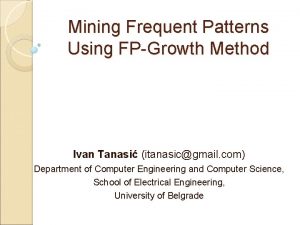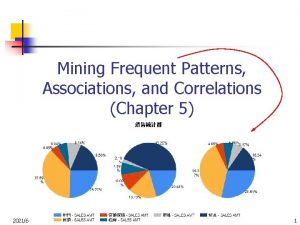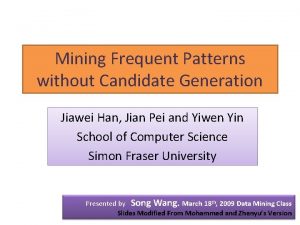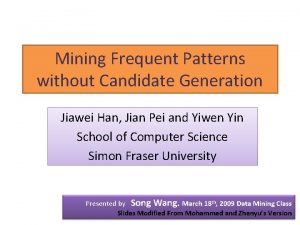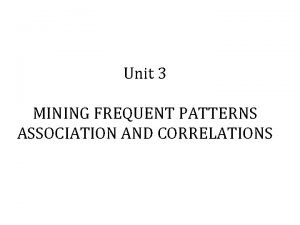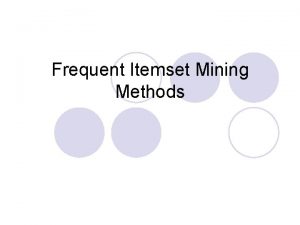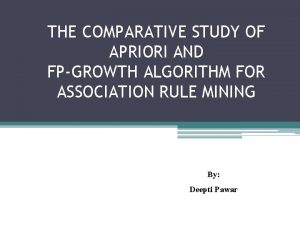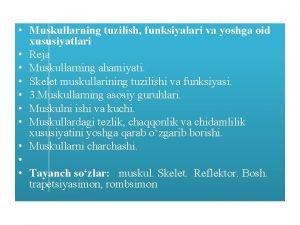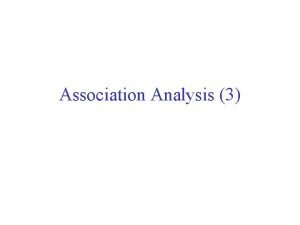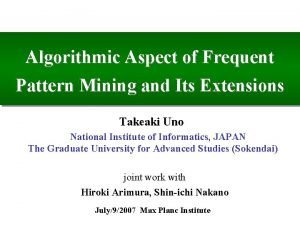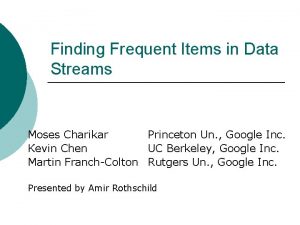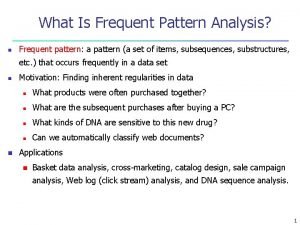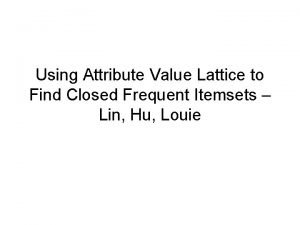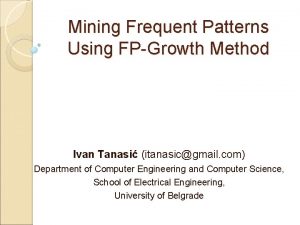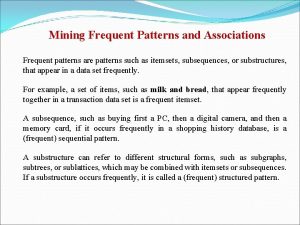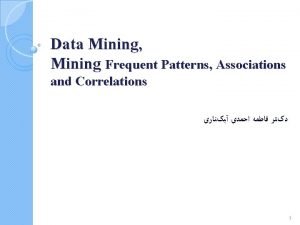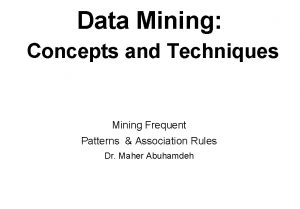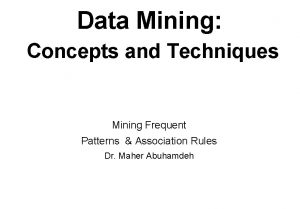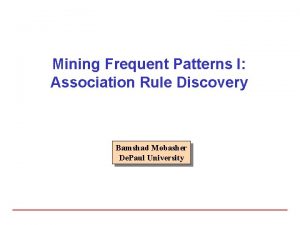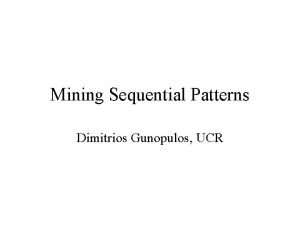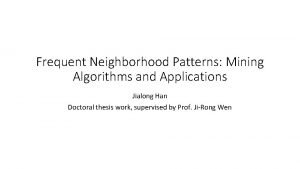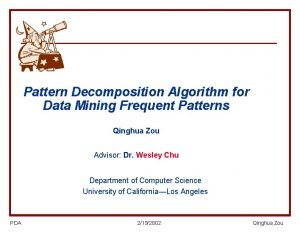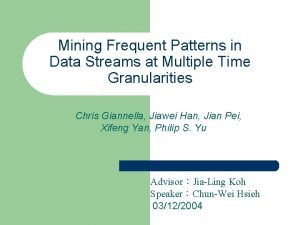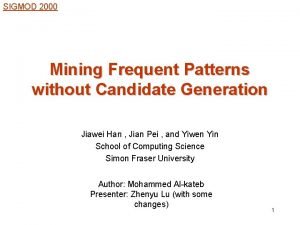Mining Frequent Patterns Using FPGrowth Method Ivan Tanasi




![Problem importance 2/2 Association rules ◦ buys(“laptop”)=>buys(“mouse”) [support = 2%, confidence = 30%] • Problem importance 2/2 Association rules ◦ buys(“laptop”)=>buys(“mouse”) [support = 2%, confidence = 30%] •](https://slidetodoc.com/presentation_image_h2/64389004257a1d9ba2603ebc040ebbf9/image-5.jpg)





















- Slides: 26

Mining Frequent Patterns Using FP-Growth Method Ivan Tanasić (itanasic@gmail. com) Department of Computer Engineering and Computer Science, School of Electrical Engineering, University of Belgrade

Mining Frequent Patterns without Candidate Generation: A Frequent-Pattern Tree Approach ◦ Jiawei Han (UIUC) ◦ Jian Pei (Buffalo) ◦ Yiwen Yin (SFU) ◦ Runying Mao (Microsoft) Ivan Tanasic (itanasic@gmail. com) 2/25

Problem Definition Mining frequent patterns from a DB ◦ Frequent intemsets (milk + bread) ◦ Frequent sequential patterns (computer -> printer -> paper) ◦ Frequent structural patterns (subgraphs, subtrees) Ivan Tanasic (itanasic@gmail. com) 3/25

Problem Importance 1/2 Basic DM primitive Used for mining data relationships ◦ Associations ◦ Correlations Helps with basic DM tasks ◦ Classification ◦ Clustering Ivan Tanasic (itanasic@gmail. com) 4/25
![Problem importance 22 Association rules buyslaptopbuysmouse support 2 confidence 30 Problem importance 2/2 Association rules ◦ buys(“laptop”)=>buys(“mouse”) [support = 2%, confidence = 30%] •](https://slidetodoc.com/presentation_image_h2/64389004257a1d9ba2603ebc040ebbf9/image-5.jpg)
Problem importance 2/2 Association rules ◦ buys(“laptop”)=>buys(“mouse”) [support = 2%, confidence = 30%] • Support=% of all transactions containing that items • Confidence=% of transactions containing I 1 that contain I 2 Ivan Tanasic (itanasic@gmail. com) 5/25

Problem Trend Apriori speedup using techniques New data structures (trees) Association rule specific algorithms Specific AR algorithms (One. R, Zero. R) FP-Growth still widely used Ivan Tanasic (itanasic@gmail. com) 6/25

Existing Solutions 1/3 (Apriori) Agrawal et al. (1994) AP: All nonempty subsets of a frequent itemset must also be frequent Starts from 1 -itemsets Join + prune (using AP + min supp) Generates huge number of candidates Ivan Tanasic (itanasic@gmail. com) 7/25

Existing Solutions 2/3 (ECLAT) Zaki (2000) Equivalence CLass Transformation Vertical format: {item, TID_set} instead of {TID, itemset} Intersects TID_sets of candidates TID_sets holds support info (no scans) Still generates candidates Ivan Tanasic (itanasic@gmail. com) 8/25

Existing Solutions 3/3 (Tree. Projection) Agarwal et al. (2001) Creates a lexicographical tree and projects db into sub-dbs based on the patterns mined so far Recursively mines subdatabases Less scalable then FP-Growth Ivan Tanasic (itanasic@gmail. com) 9/25

FP-Tree construction 1/6 Desc. supp. sort • Min support = 2 Ivan Tanasic (itanasic@gmail. com) 10/25

FP-Tree construction 2/6 Desc. supp. sort T 1={I 2, I 1, I 5} Ivan Tanasic (itanasic@gmail. com) 11/25

FP-Tree construction 3/6 Desc. supp. sort T 1 = {I 2, I 1, I 5} T 2 = {I 2, I 4} Ivan Tanasic (itanasic@gmail. com) 12/25

FP-Tree construction 4/6 Desc. supp. sort T 1 = {I 2, I 1, I 5} T 2 = {I 2, I 4} T 3 = {I 2, I 3} Ivan Tanasic (itanasic@gmail. com) 13/25

FP-Tree construction 5/6 Desc. supp. sort T 1 = {I 2, I 1, I 5} T 2 = {I 2, I 4} T 3 = {I 2, I 3} T 4 = {I 2, I 1, I 4} Ivan Tanasic (itanasic@gmail. com) 14/25

FP-Tree construction 6/6 Desc. supp. sort T 1 = {I 2, I 1, I 5} T 2 = {I 2, I 4} T 3 = {I 2, I 3} T 4 = {I 2, I 1, I 4} T 5 = {I 1, I 3} T 6 = {I 2, I 3} T 7 = {I 1, I 3} T 8 = {I 2, I 1, I 3, I 5} T 9 = {I 2, I 1, I 3} Ivan Tanasic (itanasic@gmail. com) 15/25

Mining of the FP-Tree 1/4 It. Conditional P. base Cond. FP-Tree Freq. Patterns Generated I 5 {I 2: 2, I 1: 2} {I 2, I 5: 2}, {I 1, I 5: 2}, {I 2, I 1, I 5: 2} {{I 2, I 1: 1}, {I 2, I 1, I 3: 1}} Ivan Tanasic (itanasic@gmail. com) 16/25

Mining of the FP-Tree 2/4 It. Conditional P. base Cond. FP-Tree Freq. Patterns Generated I 5 {{I 2, I 1: 1}, {I 2, I 1, I 3: 1}} {I 2: 2, I 1: 2} {I 2, I 5: 2}, {I 1, I 5: 2}, {I 2, I 1, I 5: 2} I 4 {{I 2, I 1: 1}, {I 2: 1}} {I 2: 2} {I 2, I 4: 2} Ivan Tanasic (itanasic@gmail. com) 17/25

Mining of the FP-Tree 3/4 It. Conditional P. base Cond. FP-Tree Freq. Patterns Generated I 5 {{I 2, I 1: 1}, {I 2, I 1, I 3: 1}} {I 2: 2, I 1: 2} {I 2, I 5: 2}, {I 1, I 5: 2}, {I 2, I 1, I 5: 2} I 4 {{I 2, I 1: 1}, {I 2: 1}} {I 2: 2} {I 2, I 4: 2} I 3 {{I 2, I 1: 2}, {I 2: 2}, {I 1: 2}} {I 2: 4, I 1: 2}, {I 1: 2} {I 2, I 3: 4}, {I 1, I 3: 4}, {I 2, I 1, I 3: 2} Ivan Tanasic (itanasic@gmail. com) 18/25

Mining of the FP-Tree 4/4 It. Conditional P. base Cond. FP-Tree Freq. Patterns Generated I 5 {{I 2, I 1: 1}, {I 2, I 1, I 3: 1}} {I 2: 2, I 1: 2} {I 2, I 5: 2}, {I 1, I 5: 2}, {I 2, I 1, I 5: 2} I 4 {{I 2, I 1: 1}, {I 2: 1}} {I 2: 2} {I 2, I 4: 2} I 3 {{I 2, I 1: 2}, {I 2: 2}, {I 1: 2} {I 2: 4, I 1: 2}, {I 1: 2} {I 2, I 3: 4}, {I 1, I 3: 4}, {I 2, I 1, I 3: 2} I 1 {{I 2: 4}} {I 2: 4} {I 2, I 1: 4} Ivan Tanasic (itanasic@gmail. com) 19/25

How much batter is it 1/3? Runtime on sparse data: Ivan Tanasic (itanasic@gmail. com) 20/25

How much batter is it 2/3? Runtime on mixed data: Ivan Tanasic (itanasic@gmail. com) 21/25

How much batter is it 3/3? Compactness: Ivan Tanasic (itanasic@gmail. com) 22/25

Is it Original? A lot of methods try to improve Apriori ◦ Hashing ◦ Transaction reduction ◦ Partitioning ◦ Sampling Tree. Projection uses similar structure, but it is still a different method Ivan Tanasic (itanasic@gmail. com) 23/25

Importance over time Basic primitive (strong foundation for tall building) Performance gets very important as databases are getting huge Scalability also FP-Growth has both performance and scalability Ivan Tanasic (itanasic@gmail. com) 24/25

Conclusion An important method for solving important DM tasks Fast Compact Scalable (db projection/tree on disk) Ivan Tanasic (itanasic@gmail. com) 25/25

Mining Frequent Patterns Using FPGrowth Method Ivan Tanasić (itanasic@gmail. com) Department of Computer Engineering and Computer Science, School of Electrical Engineering, University of Belgrade
 Ivan tanasi
Ivan tanasi Mining frequent patterns associations and correlations
Mining frequent patterns associations and correlations Eclat algorithm
Eclat algorithm Dbminer
Dbminer Mining frequent patterns without candidate generation
Mining frequent patterns without candidate generation Mining frequent patterns associations and correlations
Mining frequent patterns associations and correlations Apriori algorithm
Apriori algorithm Growth algorithm
Growth algorithm Muskullar sistemasining tuzilishi
Muskullar sistemasining tuzilishi Strip mining vs open pit mining
Strip mining vs open pit mining Chapter 13 mineral resources and mining worksheet answers
Chapter 13 mineral resources and mining worksheet answers Difference between strip mining and open pit mining
Difference between strip mining and open pit mining Difference between text mining and web mining
Difference between text mining and web mining Mining multimedia databases
Mining multimedia databases Mining complex data types
Mining complex data types Shooting method using euler's method
Shooting method using euler's method Icd 10 metroragia
Icd 10 metroragia Customer relationship management in retailing
Customer relationship management in retailing Acegd
Acegd Zscore
Zscore What is the prefix for frequent
What is the prefix for frequent Reverse image search
Reverse image search Frequent earthquakes in an area may indicate *
Frequent earthquakes in an area may indicate * Finding frequent items in data streams
Finding frequent items in data streams Frequent pattern
Frequent pattern Closed frequent pattern
Closed frequent pattern What is tornado
What is tornado
